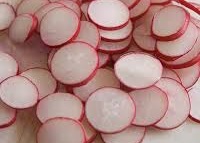 atic browning of fresh-cut fruit and vegetables is one of the main phenomena that reduce the shelf-life and affect negatively the consumer’s purchase decision.
atic browning of fresh-cut fruit and vegetables is one of the main phenomena that reduce the shelf-life and affect negatively the consumer’s purchase decision.Scientists from Argentina have investigated the effects of the application of mild heat shock and immersion in citric acid (single and combined hurdles) on fresh-cut radish in minimizing colour change during refrigerated storage at 5°C for 10 days.
Radishes (Raphanus sativus L.) were purchased from a local market in Mar del Plata, Argentina. They were washed and sliced, then the slices were subjected to the following treatments:
1. immersion of slices in citric acid solutions of 0.3, 0.6 and 0.9% (w/w) for 1 min;
2. slices were placed in sterile containers and immersed in water at 50°C for 1, 2 and 3 min. Thereafter, samples were removed from the bath and cooled immediately in cold water at 0–4°C for 3 min;
3. application of combined treatments (hurdle technology), in which heat treatment was carried out followed by immersion in citric acid solution.
Results showed that the single hurdle application of low citric acid concentration (0.3%) or intermediate immersion time (2 min) at 50°C minimized the radish slices colour changes during storage.
However, the best results were obtained by treatment combination. The combined treatment of mild heat shock (1 min/50 °C) and the immersion in a solution of 0.3% citric acid was selected as most effective in improving retention of the fresh colour of radish slices during entire storage.
The scientists conclude that the rapid discolouration due to browning that occurs on radish surfaces after slicing during minimal processing and storage can be diminished by the use of these hurdle technologies.





